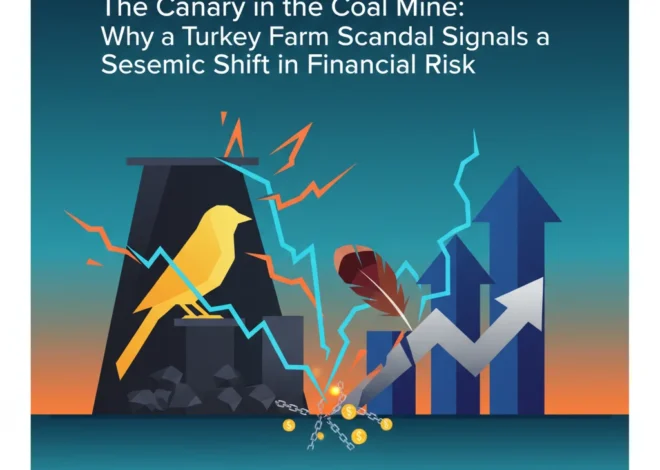
The Balance Sheet’s Blind Spot: Why “Toxic Legacy” Exposes a Multi-Trillion Dollar Risk for Investors
In the world of high-stakes finance and investing, risk is a meticulously calculated variable. Analysts build sophisticated models, algorithms parse petabytes of data, and entire departments are dedicated to forecasting the future of the stock market. Yet, what if one of the greatest financial risks isn’t hidden in future projections, but buried in the past? This is the central, chilling question brought to the forefront by the Financial Times’ new investigative podcast season, Untold: Toxic Legacy.
The series delves into a devastating story of alleged corporate negligence in Kabwe, a town in Zambia, once the site of one of the world’s largest lead mines. For decades, the operations left behind a catastrophic environmental disaster, resulting in what experts have called one of the most toxic places on Earth, with generations of children suffering from extreme lead poisoning. The podcast turns the spotlight on mining giant Anglo American, examining its historical role and subsequent departure, leaving a community to grapple with the devastating consequences.
While the human cost is immeasurable, this story is far more than a tragic headline. For finance professionals, investors, and business leaders, it is a critical case study in a category of risk that traditional financial analysis often overlooks: the long-tail liability of a company’s environmental and social footprint. It’s a stark reminder that the ghosts of corporate history can, and often do, return to haunt the modern balance sheet, impacting everything from the economy to individual trading decisions.
The Kabwe Catastrophe: An Externality Made Real
To understand the financial implications, one must first grasp the scale of the disaster. The mine in Kabwe was operated for much of the 20th century, and for a significant period, Anglo American played a key management and technical role. When the mine was eventually nationalized and later closed, the toxic infrastructure and waste were left behind. According to a 2019 report by Human Rights Watch, blood lead levels in some children in Kabwe were found to be “more than ten times the level the US Centers for Disease Control and Prevention considers to be of concern,” leading to severe health problems and developmental issues (source).
In economics, this is a textbook example of a negative externality—a cost imposed on a third party who is not directly involved in a transaction. For decades, the profits from mining were privatized, while the immense costs of pollution and public health crises were socialized, borne by the people of Kabwe and the Zambian government. However, the financial world is slowly awakening to the fact that these externalities don’t disappear. They accumulate, representing a form of hidden debt that can materialize decades later in the form of massive lawsuits, regulatory fines, and brand annihilation.
A class-action lawsuit has been brought against Anglo American in South Africa, seeking compensation for the victims. Regardless of the legal outcome, the case forces a crucial question upon the investment community: how do you price a company’s history? How does the stock market account for a “toxic legacy” that could unleash billions in liabilities at any moment?
From Environmental Disaster to Financial Contagion
The link between environmental negligence and financial performance is not theoretical; it’s a well-documented pattern. A single catastrophic event can erase billions in market capitalization, trigger credit downgrades, and occupy management’s attention for years, diverting resources from innovation and growth. The financial services sector, from banking to trading, is increasingly forced to model these high-impact, low-probability “black swan” events.
To put the potential financial scale into perspective, consider some of the most infamous corporate disasters in history. The following table provides a glimpse into the staggering economic consequences of environmental and social failures.
A Brief History of Corporate Disasters and Their Financial Costs
| Event (Company) | Year | Description | Estimated Financial Cost (USD) |
|---|---|---|---|
| Bhopal Gas Tragedy (Union Carbide) | 1984 | A gas leak at a pesticide plant in India killed thousands and affected over 500,000 people. | $470 million settlement (1989), with ongoing calls for much higher compensation. Dow Chemical, which later acquired Union Carbide, has faced continued reputational and legal challenges. |
| Exxon Valdez Oil Spill (Exxon) | 1989 | An oil tanker struck a reef in Alaska, spilling 11 million gallons of crude oil. | Over $4.3 billion in cleanup costs, fines, and compensation. |
| Deepwater Horizon Oil Spill (BP) | 2010 | An explosion on an oil rig in the Gulf of Mexico caused the largest marine oil spill in history. | Over $65 billion in fines, cleanup costs, and settlements (source). |
| Volkswagen Emissions Scandal (VW) | 2015 | The company was found to have deliberately programmed diesel engines with “defeat devices” to cheat on emissions tests. | Over $35 billion in fines, recalls, and legal settlements to date. |
These figures, while immense, only represent the direct costs. They don’t capture the long-term damage to brand equity, the loss of consumer trust, or the increased cost of capital as lenders and investors view the company as a higher risk. The “Toxic Legacy” case against Anglo American, should it succeed, could set a new precedent for holding parent companies accountable for the actions of their international subsidiaries, even decades after the fact. This has profound implications for the global economy and multinational corporations.
The Fintech and ESG Revolution: A New Arsenal for Investors
For decades, investors had to rely on company-issued reports and traditional financial statements, which rarely, if ever, disclosed the full extent of environmental or social risks. Today, the landscape is changing, driven by the dual forces of ESG consciousness and advances in financial technology.
The modern investor has access to an unprecedented amount of information. Here’s how technology is helping to uncover these hidden liabilities:
- Alternative Data: Fintech platforms are now integrating non-traditional data sources into their analysis. This includes satellite imagery to monitor deforestation or industrial pollution in real-time, sentiment analysis from news and social media to gauge public opinion, and data from watchdog organizations that flag corporate malfeasance.
- AI-Powered Due Diligence: Artificial intelligence can scan and analyze thousands of documents—including historical archives, court records, and scientific reports—to identify patterns of risk that a human analyst might miss. This technology can help connect the dots between a parent company and the actions of a subsidiary from 40 years ago.
- Supply Chain Transparency: While still an emerging technology in this space, blockchain holds the potential to create immutable records of a product’s journey, from raw material extraction to the final consumer. This could, in theory, help hold companies accountable for environmental or labor violations within their supply chains, preventing future “toxic legacies” from being created.
This technological shift is fundamentally changing the nature of banking and investing. Lenders are incorporating climate and social risk into their loan pricing, and asset managers who ignore these factors risk significant underperformance. The principles of sound economics are expanding to include the costs that were previously left off the books.
Actionable Insights for Leaders and Investors
The story of Kabwe, as amplified by the Financial Times, is not just a cautionary tale; it’s a strategic imperative. It demands a new way of thinking for anyone involved in the flow of capital.
For Investors:
- Look Beyond the Rating: ESG scores are a starting point, not a conclusion. Dig deeper into a company’s history, especially those in extractive or heavy industries. Ask hard questions about how they have handled past controversies and decommissioned assets.
- Embrace Active Ownership: Use your power as a shareholder to demand transparency and accountability for historical liabilities. Engage with management on their plans for remediation and risk mitigation.
- Diversify Your Information Diet: Don’t rely solely on company disclosures. Follow investigative journalism, read reports from NGOs, and use modern fintech tools that provide a more holistic view of risk.
For Business Leaders:
- Conduct Historical Audits: Proactively investigate your own company’s past operations. It is far better to identify and address a potential “toxic legacy” on your own terms than to have it exposed through a lawsuit or media investigation.
- Integrate Long-Term Liability into Strategy: Corporate strategy must extend beyond the next quarter. The true cost of doing business includes the eventual decommissioning of assets and the remediation of any environmental impact. Factor these costs into your financial planning from day one.
- Redefine Corporate Social Responsibility (CSR): Move away from philanthropic gestures and toward genuine operational accountability. A true social license to operate is earned by preventing harm, not just by donating to charities after the fact. According to a 2021 study, companies with high ESG scores demonstrated greater resilience during the COVID-19 crisis, suggesting a strong link between sustainability and financial performance (source).
The Final Word
The “Toxic Legacy” of Kabwe is a microcosm of a global challenge. It demonstrates that in an interconnected world, there is no “away” to throw things. The environmental and social debts of the past will eventually come due. For the financial community, this represents both a monumental risk and a profound opportunity.
By learning the lessons from stories like this, investors can better protect their capital, business leaders can build more resilient and sustainable enterprises, and the financial system as a whole can become a more powerful force for positive change. The most important takeaway is simple: the most dangerous risks are the ones you choose to ignore. The stock market may have a short memory, but the earth and its people do not.


